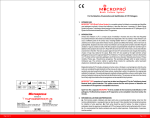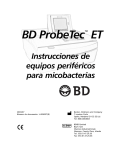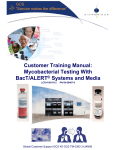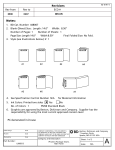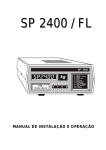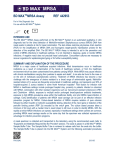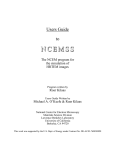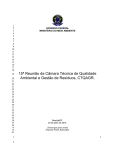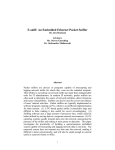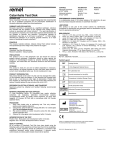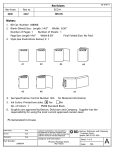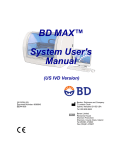Download Package Insert
Transcript
SO 0191-5 Revisions Rev from Rev to 0908 2010/07 ECO # 5132-09 Notes: 1. BD Cat. Number 441123 2. Blank (Sheet) Size: Length: 8.5 Width: 11 Number of Pages: 12 Number of Sheets: 3 Page Size: Length 8.5 Width 5.5 Final Folded Size: 8.5 x 5.5 3. Style (see illustrations below): # 5 #1 #2 #5 #6 #3 #4 #7 4. See Specification Control Number BALT 8080185 for Material Information 5. Ink Colors: Printed two sides x Yes No No. of Colors: 1 PMS# Standard Black 6. Graphics are approved by Becton, Dickinson and Company. Supplier has the responsibility for using the most current approved revision level Label Design Date Proofer Date Checked By Date Part Number: 8080185 COMPANY CONFIDENTAL. THIS DOCUMENT IS THE PROPERTY OF BECTON, DICKINSON AND COMPANY AND IS NOT TO BE USED OUTSIDE THE COMPANY WITHOUT WRITTEN PERMISSION Category and Description Package Insert, BD ProbeTec ET GC/AC Amplified DNA Assay Becton, Dickinson and Company 7 Loveton Circle Sparks, MD 21152 USA Sheet: 1 of 13 Scale: N/A A ™ % ProbeTec ET Neisseria gonorrhoeae Amplified DNA Assay 8 8080185 2010/07 INTENDED USE The BD ProbeTec™ ET Neisseria gonorrhoeae (GC) Amplified DNA Assay, when tested with the BD Viper™ System, uses Strand Displacement Amplification (SDA) technology for the direct, qualitative detection of Neisseria gonorrhoeae DNA in endocervical swabs, male urethral swabs, and in female and male urine specimens as evidence of infection with N. gonorrhoeae. Specimens may be from symptomatic or asymptomatic females and males. A separate Amplification Control is used for inhibition testing. SUMMARY AND EXPLANATION Neisseria gonorrhoeae are gram-negative, oxidase positive diplococci which can be observed in Gram-stained smears of urethral discharges, usually within neutrophils. Culture of N. gonorrhoeae can be difficult because the organism does not survive long outside its host and is highly susceptible to adverse environmental conditions such as drying and extreme temperatures.1 Neisseria gonorrhoeae causes acute urethritis in males, which if untreated can develop into epididymitis, prostatitis, and urethral stricture. In females, the primary site of infection is the endocervix. An important complication in females is development of pelvic inflammatory disease which contributes to infertility.2 Asymptomatic infections occur often in females but infrequently in males. The current methods for detection of N. gonorrhoeae include culture, immunoassays, non-amplified probes, and amplified probes.1,2 The development of amplified methods has demonstrated two advantages over non-amplified methods: increased sensitivity, and applicability to a variety of sample types. For identification of GC, optimized culture methods continue to be the standard for diagnosing patients with gonococcal infections. The BD ProbeTec ET Neisseria gonorrhoeae Amplified DNA Assay, when used with the BD Viper System, utilizes homogeneous Strand Displacement Amplification (SDA) technology as the amplification method and fluorescent energy transfer (ET) as the detection method to test for the presence of N. gonorrhoeae DNA in clinical specimens.3-5 PRINCIPLES OF THE PROCEDURE The BD ProbeTec ET Neisseria gonorrhoeae Amplified DNA Assay is based on the simultaneous amplification and detection of target DNA using amplification primers and a fluorescent labeled detector probe.4,5 The SDA reagents are dried in two separate disposable microwell strips. The processed sample is added to the Priming Microwell which contains the amplification primers, fluorescent labeled detector probe, and other reagents necessary for amplification. After incubation, the reaction mixture is transferred to the Amplification Microwell, which contains two enzymes (a DNA polymerase and a restriction endonuclease) necessary for SDA. The Amplification Microwells are sealed to prevent contamination and then incubated in a thermally controlled fluorescent reader which monitors each reaction for the generation of amplified products. The presence or absence of GC is determined by relating the BD ProbeTec ET MOTA (Method Other Than Acceleration) scores for the sample to pre-determined cutoff values. The MOTA score is a metric used to assess the magnitude of signal generated as a result of the reaction. Each sample and control are tested in two discrete microwells: one for N. gonorrhoeae and one for the Amplification Control. The purpose of the Amplification Control is to identify a sample that may inhibit the SDA reaction. REAGENTS Each BD ProbeTec ET GC/AC Reagent Pack contains: Neisseria gonorrhoeae (GC) Priming Microwells, 4 x 96: 4 Oligonucleotides ≥ 7 pmol; dNTP ≥ 35 nmol; Detector probe ≥ 25 pmol; with buffers and stabilizers. Neisseria gonorrhoeae (GC) Amplification Microwells, 4 x 96: Restriction enzyme ≥ 15 Units; DNA Polymerase ≥ 2 Units; dNTP’s ≥ 80 nmol; with buffers and stabilizers. Amplification Control (AC) Priming Microwells, 4 x 96: 4 Oligonucleotides ≥ 7 pmol; dNTP ≥ 35 nmol; Detector probe ≥ 25 pmol; ≥ 1,000 copies per reaction of pGC10 linearized plasmid; with buffers and stabilizers. Amplification Control (AC) Amplification Microwells, 4 x 96: Restriction enzyme ≥ 15 Units; DNA Polymerase ≥ 2 Units; dNTP’s ≥ 80 nmol; with buffers and stabilizers. NOTE: Each microwell pouch contains one desiccant bag. BD ProbeTec ET (CT/GC) Control Set, 20 CT/GC Positive Controls (50 µL dried) containing 750 copies per reaction of pCT16 linearized plasmid* and 250 copies per reaction of pGC10 linearized plasmid* with ≥ 5 µg Salmon testes DNA; 20 CT/GC Negative Controls (50 µL dried) with ≥ 5 µg Salmon testes DNA; BD ProbeTec ET CT/GC Diluent Tubes – 400 tubes each containing 2 mL of Sample Diluent, which contains potassium phosphate, DMSO, glycerol, Polysorbate 20, and 0.03% Proclin™ (preservative); BD ProbeTec ET Diluent (CT/GC) – 225 mL Sample Diluent which contains potassium phosphate, DMSO, glycerol, Polysorbate 20, and 0.03% Proclin (preservative). * The concentration of this DNA was determined spectrophotometrically at 260 nm. Instrument, equipment and supplies: BD Viper, BD Viper Lysing Heater, BD Viper Lysing Rack and base, BD ProbeTec Urine Preservative Transport Kit, BD ProbeTec ET Sample Tubes and Caps. BD Viper pipette tips, tip waste boxes and bags, Amplification (Black) plate sealers, BD ProbeTec ET Chlamydia trachomatis/Neisseria gonorrhoeae (CT/GC) Amplified DNA Assay Endocervical Specimen Collection and DRY TRANSPORT Kit or BD ProbeTec ET CT/GC Amplified DNA Assay Collection Kit for Endocervical Specimens, BD ProbeTec ET Chlamydia trachomatis/Neisseria gonorrhoeae CT/GC Amplified DNA Assay Male Urethral Specimen Collection and DRY TRANSPORT Kit or BD ProbeTec ET CT/GC Amplified DNA Assay Collection Kit for Male Urethral Specimens. Materials Required But Not Provided: Centrifuge capable of 2000 x g, vortex mixer, gloves, pipettes capable of delivering 1 mL, 2 mL and 4 mL, DNA AWAY™ or 1% (v/v) sodium hypochlorite, clean container suitable for holding aliquotted Diluent, timer and absorbent paper, sterile urine specimen collection cups. Empty microwells and alcohol wipes (70% Isopropanol). *Mix 200 mL of bleach with 800 mL of water. Storage and Handling Requirements: Reagents may be stored at 2 – 33°C. Unopened Reagent Packs are stable until the expiration date. Once a pouch is opened, the microwells are stable for 4 weeks if properly sealed or until the expiration date, whichever comes first. Do not freeze. Warnings and Precautions: For in vitro Diagnostic Use 1. Wear personal protective equipment, including eye protection, when handling biological specimens. 2. This reagent pack is for testing endocervical and male urethral swabs and male and female urine specimens with the BD Viper System. 3. For collection of endocervical swab specimens, only the BD ProbeTec ET Chlamydia trachomatis/Neisseria gonorrhoeae (CT/GC) Amplified DNA Assay Endocervical Specimen Collection and DRY TRANSPORT Kit and the BD ProbeTec ET CT/GC Amplified DNA Assay Collection Kit for Endocervical Specimens have been validated. 4. For collection of male urethral swab specimens, only the BD ProbeTec ET Chlamydia trachomatis/Neisseria gonorrhoeae (CT/GC) Amplified DNA Assay Male Urethral Specimen Collection and DRY TRANSPORT Kit and the BD ProbeTec ET CT/GC Amplified Assay Collection Kit for Male Urethral Specimens have been validated. 5. For urine specimens, the BD ProbeTec Urine Preservative Transport (UPT), and unpreserved (neat) urine have been validated. 6. The BD ProbeTec Urine Preservative Transport (UPT) Kit contains NAP Guard™ (≥ 742.5 mM K2EDTA). NAP Guard may be irritating to the eyes, skin and respiratory system. In case of contact with eyes, rinse opened eye immediately with plenty of water and seek medical advice if symptoms persist. After contact with skin, wash immediately with plenty of soap and water. If inhaled, seek medical attention in case of problems. 7. Laboratories may validate other swab or urine collection and transport devices for use with the BD ProbeTec ET GC assay according to the “Verification and Validation Procedures in the Clinical Microbiology Laboratory,” Cumitech 31, B.L. Elder et al., American Society for Microbiology, Washington D.C., February, 1997. 8. Do not test the CT/GC Diluent tube from the BD ProbeTec ET CT/GC Amplified Assay Collection Kits if received in the laboratory without the swab present. A false negative test result may occur. 9. Do not interchange or mix kit reagents from kits with different lot numbers. 10. Pathogenic microorganisms, including hepatitis viruses and Human Immunodeficiency Virus, may be present in clinical specimens. “Standard Precautions” 6-9 and institutional guidelines should be followed in handling all items contaminated with blood and other body fluids. 11. Use established laboratory practices when disposing of used pipette tips, sample tubes, Priming Microwells and other disposables. Discard disposables carefully. Seal and dispose of waste containers when they are 3/4 full or daily (whichever comes first). 12. The BD ProbeTec ET Diluent (CT/GC) and CT/GC Diluent tube contain dimethyl sulfoxide (DMSO). DMSO is harmful by inhalation, contact with skin or if swallowed. Avoid contact with eyes. In case of contact with eyes, rinse immediately with plenty of water and seek medical advice. After contact with skin, wash immediately with plenty of water. 13. Reagent pouches containing unused Priming Microwells and Amplification Microwells MUST be carefully resealed after opening. Verify that a desiccant is present prior to resealing the reagent pouches. 14. The plate containing the Amplification Microwells MUST be properly sealed with the black Amplification Sealer. Sealing ensures a closed reaction for amplication and detection and is necessary to avoid contamination of the instrument and work area with amplification products. Do not remove sealing material from microwells at any time. 15. Priming Microwells with residual fluid (after transfer of fluid from the Priming Microwells to the Amplification Microwells) represent a source of target contamination. Carefully seal Priming Microwells with a plate sealer prior to disposal. 16. To prevent contamination of the work environment with amplification products, use the disposal bags provided in the Reagent Packs to dispose of tested Amplification Microwells. Make sure the bags are properly closed before disposal. 17. Although dedicated work areas are not required because the BD Viper System design reduces the possibility of amplicon contamination in the testing environment, other precautions for controlling contamination, particularly to avoid contamination of specimens during processing, are necessary. 18. Because of the potential for false positivity with some non-gonococcal Neisseria found in the respiratory tract (see “Limitations of the Procedure,” #19), contamination of reagents and specimens with respiratory aerosols should be avoided. 2 19. CHANGE GLOVES after removing and discarding caps from lysed samples and controls to avoid crosscontamination of specimens. If gloves come in contact with specimen or appear to be wet, immediately change gloves to avoid contaminating other specimens. Change gloves before leaving work area and upon entry into work area. 20. In the event of contamination of the work area or equipment with samples or controls, thoroughly clean the contaminated area with DNA AWAY or 1% (v/v) sodium hypochlorite and rinse thoroughly with water. Allow surface to dry completely before proceeding. 21. Clean the entire work area – counter tops and instrument surfaces – with DNA AWAY or 1% (v/v) sodium hypochlorite on a daily basis. Thoroughly rinse with water. Allow surfaces to dry completely before proceeding with additional testing. 22. Do not use ELIMINase or Alconox for cleaning the BD Viper System. 23. When using hydrogen peroxide as a cleaning agent, do not use hydrogen peroxide from a bottle that has been open > 8 days. 24. Contact Technical Services in the event of an unusual situation, such as a spill into the BD Viper instrument or DNA contamination that cannot be removed by cleaning. SAMPLE COLLECTION AND TRANSPORT The BD Viper System is designed to detect the presence of Neisseria gonorrhoeae in endocervical swabs, male urethral swabs and male and female urine specimens using the appropriate collection method. The only devices that have been validated for collecting swab specimens for testing on the BD Viper System are: • BD ProbeTec ET Chlamydia trachomatis/Neisseria gonorrhoeae (CT/GC) Amplified DNA Assay Endocervical Specimen Collection and DRY TRANSPORT Kit • BD ProbeTec ET Chlamydia trachomatis/Neisseria gonorrhoeae (CT/GC) Amplified DNA Assay Male Urethral Specimen Collection and DRY TRANSPORT Kit • BD ProbeTec ET Chlamydia trachomatis/Neisseria gonorrhoeae (CT/GC) Amplified DNA Assay Collection Kit for Endocervical Specimens • BD ProbeTec ET Chlamydia trachomatis/Neisseria gonorrhoeae (CT/GC) Amplified Assay Collection Kit for Male Urethral Specimens For U.S. and international shipments, specimens should be labeled in compliance with applicable state, federal, and international regulations covering the transport of clinical specimens and etiologic agents/infectious substances. Time and temperature conditions for storage must be maintained during transport. Urine specimens must be collected in a sterile, plastic, preservative-free, specimen collection cup. For urine specimens, the BD ProbeTec Urine Preservative Transport (UPT), and unpreserved (neat) urine have been validated. Swab Specimen Collection Endocervical Swab Specimen Collection using BD ProbeTec ET CT/GC Amplified DNA Assay Endocervical Specimen Collection and DRY TRANSPORT Kit: 1. Remove excess mucus from the cervical os with the large-tipped cleaning swab provided in the BD ProbeTec ET CT/GC Amplified DNA Assay Endocervical Specimen Collection and DRY TRANSPORT Kit and discard. 2. Insert the Endocervical Specimen Collection and DRY TRANSPORT swab into the cervical canal and rotate for 15 – 30 s. 3. Withdraw the swab carefully. Avoid contact with the vaginal mucosa. 4. Immediately place the cap/swab into the transport tube. Make sure the cap is tightly secured to the tube. 5. Label the tube with patient information and date/time collected. 6. Transport to laboratory. Endocervical Swab Specimen Collection using BD ProbeTec ET CT/GC Amplified DNA Assay Collection Kit for Endocervical Specimens: 1. Remove the cleaning swab from packaging. 2. Using cleaning swab, remove excess mucus from the cervical os. 3. Discard the used cleaning swab. 4. Remove the collection swab from packaging. 5. Insert the collection swab into the cervical canal and rotate for 15 – 30 s. 6. Withdraw the swab carefully. Avoid contact with the vaginal mucosa. 7. Uncap the CT/GC diluent tube. 8. Fully insert the collection swab into the CT/GC Diluent tube. 9. Break the shaft of the swab at the score mark. Use care to avoid splashing of contents. 10. Tightly recap the tube. 11 Label the tube with patient information and date/time collected. 12. Transport to laboratory. Male Urethral Swab Specimen Collection using BD ProbeTec ET CT/GC Amplified DNA Assay Male Urethral Collection and DRY TRANSPORT Kit: 1. Insert the Male Urethral Collection and DRY TRANSPORT swab 2 – 4 cm into the urethra and rotate for 3 – 5 s. 2. Withdraw the swab and place the cap/swab into the transport tube. Make sure the cap is tightly secured to the tube. 3. Label the tube with patient information and date/time collected. 4. Transport to laboratory. 3 Male Urethral Swab Specimen Collection using BD ProbeTec ET CT/GC Amplified Assay Collection Kit for Male Urethral Specimens: 1. Remove the swab from packaging. 2. Insert the swab 2 – 4 cm into the urethra and rotate for 3 – 5 s. 3. Withdraw the swab. 4. Uncap the CT/GC Diluent tube. 5. Fully insert the swab into the CT/GC Diluent tube. 6. Break the shaft of the swab at the score mark. Use care to avoid splashing of contents. 7. Tightly recap the tube. 8. Label the tube with patient information and date/time collected. 9. Transport to laboratory. Swab Storage and Transport After collection, the endocervical swabs and the male urethral swabs must be stored and transported to the laboratory and/or test site at 2 – 27°C within 4 – 6 days. Storage up to 4 days has been validated with clinical specimens; storage up to 6 days has been demonstrated with seeded specimens. In addition, storage up to 30 days at 2 – 8°C has been demonstrated with seeded specimens. Refer to “Performance Characteristics.” NOTE: If specimens cannot be transported directly to the testing laboratory under ambient temperatures (15 – 27°C) and must be shipped, an insulated container with ice should be used with either an overnight or 2-day delivery vendor. Specimen Type to be Processed Female Endocervical Male Urethral Temperature Condition for Transport to Test Site and Storage 2 – 27°C 2 – 8°C 2 – 27°C 2 – 8°C Process Specimen According to Instructions Within 4 – 6 days of collection Within 30 days of collection Within 4 – 6 days of collection Within 30 days of collection Urine Specimen Collection, Storage and Transport Collect urine specimen in a sterile, preservative-free collection cup. Urine specimens may be stored and transported in two ways – (1) unpreserved (neat), and (2) using the BD ProbeTec Urine Preservative Transport (UPT). The following chart provides a summary of storage and transport conditions for neat urine and UPT. Urine Specimen Type to be Processed NEAT UPT Urine Stored at 2 – 30°C Transfer to UPT Within 8 Hours of Collection Temperature Condition for Transport to Test Site and Storage Process Specimen According to Instructions Urine Stored at 2 – 8°C Transfer to UPT Within 24 Hours of Collection 2 – 30°C 2 – 8°C -20°C 2 – 30°C 2 – 30°C -20°C Within 30 hours of collection Within 7 days of collection Within 2 months of collection Within 30 days after transfer to UPT Within 30 days after transfer to UPT Within 2 months after transfer to UPT Unpreserved (Neat) Urine Collection 1. The patient should not have urinated for at least 1 h prior to specimen collection. 2. Collect the specimen in a sterile, preservative-free specimen collection cup. 3. The patient should collect the first 15 – 60 mL of voided urine (the first part of the stream – not midstream) into a urine collection cup. 4. Cap and label the urine collection cup with patient identification and date/time collected. Storage and Transport 1. Store and transport neat urine from the collection site to the test site at 2 – 30°C. 2. Sample processing must be completed within 30 h of collection if stored at 2 – 30°C or within 7 days of collection if stored at 2 – 8°C. NOTE: Specimens must be shipped in an insulated container with ice using either an overnight or 2-day delivery vendor. Storage up to 7 days at 2 – 8°C has been demonstrated with seeded specimens. 4 Using BD ProbeTec Urine Preservative Transport Kit (UPT) Collection 1. The patient should not have urinated for at least 1 h prior to specimen collection. 2. Collect the specimen in a sterile, preservative-free specimen collection cup. 3. The patient should collect the first 15 – 60 mL of voided urine (the first part of the stream – not midstream) into a urine collection cup. 4. Cap and label the urine collection cup with patient identification and date/time collected. Urine Transfer to UPT NOTES: Urine should be transferred from collection cup to the UPT within 8 h of collection provided the urine has been stored at 2 – 30°C. Urine can be held for up to 24 h prior to transfer to the UPT provided that the urine has been stored at 2 – 8°C. Wear clean gloves when handling the UPT and the urine specimen. If gloves come in contact with the specimen, immediately change gloves to prevent contamination of other specimens. 1. After the patient has collected the urine sample, label the urine collection cup. 2. Open the Urine Preservative Transport Kit and remove the UPT and the transfer pipette. Label the UPT with the patient identification and date/time collected. 3. Hold the UPT upright and firmly tap the bottom of the tube on a flat surface to dislodge any large drops from inside the cap. Repeat if necessary. 4. Uncap the UPT and use the transfer pipette to transfer urine into the tube. The correct volume of urine has been added when the fluid level is between the black lines on the fill window on the UPT label. This volume corresponds to approximately 2.5 – 3.45 mL of urine. DO NOT overfill or under fill the tube. 5. Discard the transfer pipette. NOTE: The transfer pipette is intended for use with a single specimen. 6. Tighten the cap securely on the UPT. 7. Invert the UPT 3 – 4 times to ensure that the specimen and reagent are well mixed. UPT Storage and Transport Store and transport urine specimens in UPT at 2 – 30°C and process within 30 days of collection. Specimens may be stored at -20°C for up to two months. TEST PROCEDURE The optimum environmental conditions for the GC assay were found to be 18 – 23°C at 25 – 75% Relative Humidity and 23 – 28°C at 25 – 50% Relative Humidity. The performance of the GC assay at temperatures in excess of 28°C is not recommended. Refer to the BD Viper Instrument User’s Manual for specific instructions for operating and maintaining the instrument. Testing Procedure for the GC/AC Reagent Pack: Refer to the BD Viper Instrument User’s Manual Addendum for the test procedure. QUALITY CONTROL The BD ProbeTec ET Chlamydia trachomatis/Neisseria gonorrhoeae positive and negative control set is provided separately. One positive and one negative control must be included in each assay run and for each new reagent kit lot number. Controls may be randomly positioned. The CT/GC positive control will monitor for substantial reagent failure only. The CT/GC negative control monitors for reagent and/or environmental contamination. The positive control has both cloned CT and GC target regions that are not necessarily representative of organism target DNA detected by the assay nor do they represent specimen matrices (urine and epithelial cell suspensions) indicated for use with the BD ProbeTec ET System. These controls may be used for internal quality control or users may develop their own internal quality control material, as described by CLSI C24-A3.10 Additional controls may be tested according to guidelines or requirements of local, state, and/or federal regulations or accrediting organizations. Refer to CLSI C24-A3 for additional guidance on appropriate internal quality control testing practices. The positive control contains 750 copies per reaction of pCT16 linearized plasmid and 250 copies per reaction of pGC10 linearized plasmid. Both organisms have multiple copies of the target. The BD ProbeTec ET amplification reaction volume is 100 µL of rehydrated control. Correct positioning of the microwell strips is important for proper result reporting. Refer to the BD Viper Instrument User’s Manual Addendum for correct microwell strip positioning. The CT/GC positive and CT/GC negative control must test as positive and negative, respectively, in order to report patient results. If controls do not perform as expected, the assay run is considered invalid and patient results will not be reported by the instrument. If the QC does not meet the expected results, repeat the entire run using a new set of controls, new microwells, and the processed specimens. If the repeat QC does not provide the expected results, contact Technical Services. (See "Interpretation of Results.") D. Quality Control Preparation: NOTE: The BD ProbeTec ET (CT/GC) Controls and Diluent should be at room temperature prior to use. 1. For each run (plate) to be tested, prepare a fresh CT/GC Negative Control Tube and a fresh CT/GC Positive Control Tube. If a plate contains more than one Reagent Pack lot number, controls must be tested with each lot. 2. Remove the cap from the CT/GC Negative Control Tube. Using a new pipette tip or pipette, add 2.0 mL of Diluent. 3. Recap the tube and vortex for 5 s. 4. Remove the cap from the CT/GC Positive Control Tube. Using a new pipette tip or pipette, add 2.0 mL of Diluent. 5. Recap the tube and vortex for 5 s. 6. Controls are ready to be lysed. 5 Once the controls have been prepared, continue with testing as described in the BD Viper Instrument User’s Manual Addendum. When the GC/AC Reagent Pack is used, the AC must be included for each patient sample and control. The Amplification Control microwells contain ≥ 1000 copies per reaction of pGC10 linearized plasmid that should be amplified in the sample matrix. The amplification control is designed to identify samples that may contain amplification inhibitors that could prevent detection of GC DNA if present. (See "Interpretation of Results.") Intepretation of Control Results: Control Interpretation without the AC CT/GC Positive Control CT/GC Negative Control GC MOTA Score MOTA ≥ 2000 MOTA < 2000 Result Acceptable Acceptable Control Interpretation with the AC GC MOTA Score CT/GC Positive Control MOTA ≥ 2000 CT/GC Negative Control MOTA < 2000 * If the AC fails (MOTA < 1000), the control fails. AC MOTA Score* MOTA ≥ 1000 MOTA ≥ 1000 Result Acceptable Acceptable Specimen Processing Controls: Specimen processing controls may be tested in accordance with the requirements of appropriate accrediting organizations. A positive control should test the entire assay system. For this purpose, known positive specimens can serve as controls by being processed and tested in conjunction with unknown specimens. Specimens used as processing controls must be stored, processed, and tested according to the package insert. As an alternative to using positive specimens, specimen processing controls simulating urine processing can be prepared as described below. Neisseria gonorrhoeae: If a known positive specimen is not available, another approach is to assay a stock culture of N. gonorrhoeae (available from the ATCCTM, strain # 19424) prepared as described below: 1. Thaw a vial of N. gonorrhoeae stock culture, received from ATCC and immediately inoculate a chocolate agar plate. 2. Incubate at 37°C in 3 – 5% CO2 for 24 – 48 h. 3. Resuspend colonies from the chocolate agar plate with phosphate buffered saline (PBS). 4. Dilute cells in PBS to a 1.0 McFarland turbidity standard (approximately 3 X 108 cells/mL). 5. Prepare 10-fold serial dilutions to a 105 dilution of the McFarland (at least 5 mL final volume) in PBS. 6. Place 4 mL of the 105 dilution in a BD ProbeTec ET sample tube. 7. Process as a urine sample starting at Section C, step 5 of the “Test Procedure.” 8. After processing, lyse sample as described in Section E of the “Test Procedure.” 9. Continue testing as described in Section F of the “Test Procedure.” Monitoring for the Presence of DNA Contamination: Refer to the BD Viper Instrument User’s Manual Addendum. INTERPRETATION OF TEST RESULTS The BD ProbeTec ET Neisseria gonorrhoeae Amplified DNA Assay uses fluorescent energy transfer as the detection method to test for the presence of N. gonorrhoeae in clinical specimens. All calculations are performed automatically by the instrument software. The presence or absence of N. gonorrhoeae is determined by relating the BD Viper MOTA scores for the specimen to pre-determined cutoff values. The MOTA score is a metric used to assess the magnitude of signal generated as a result of the reaction. The magnitude of the MOTA score is not indicative of the level of organism in the specimen. If assay controls are not as expected, patient results should not be reported. See QC section for expected control values. Reported results are determined as follows. For the GC/AC Reagent Pack: N. gonorrhoeae Result Interpretation with AC GC AC MOTA MOTA Score Score Report ≥ 10,000 Any N. gonorrhoeae detected by SDA 2000 – 9,999 < 2000 Any < 2000 < 1000 1 ≥ 1000 N. gonorrhoeae detected by SDA N. gonorrhoeae not detected by SDA Amplification control inhibited. Repeat test 4 Interpretation Result Positive for N. gonorrhoeae. N. gonorrhoeae organism Positive1 viability and/or infectivity cannot be inferred since target DNA may persist in the absence of viable organisms. N. gonorrhoeae likely. Supplemental testing may be Low Positive1,2,3 useful for verifying presence of N. gonorrhoeae.2 Presumed negative for N. gonorrhoeae. A negative Negative result does not preclude N. gonorrhoeae infection because results are dependent on adequate specimen collection, absence of inhibitors, and sufficient DNA to be detected. Repeatedly inhibitory specimen. N. gonorrhoeae, Indeterminate if present, would not be detectable using SDA. Submit another specimen for testing. According to CDC guidelines, “consideration should be given to routine additional testing for persons with positive N. gonorrhoeae screening tests when risk-factor information or actual surveys indicate that the prevalence is low, 6 resulting in a lower PPV (e.g., < 90%).” Regardless of the screening method used (e.g. NAAT, DFA, EIA, Nucleic Acid Probe), ”all positive screening tests should be considered presumptive evidence of infection.”11 Refer to CDC guidelines for details on additional testing and patient management after a positive screening test. 2 Refer to cutoff description and Figures 2 and 3 in “Performance Characteristics” of the BD ProbeTec ET CT/GC Amplified DNA Assay package insert for additional information on the distribution of GC MOTA values by specimen type observed in the clinical trials. 3 The magnitude of the MOTA score is not indicative of the level of organism in the specimen. 4 Repeat BD Viper test. For urines, repeat from the original specimen. If original specimen not available, repeat from the processed sample tube. For swabs, repeat from the processed sample tube. If repeat result is either positive or negative, interpret as described above. If results repeat as indeterminate, a new specimen should be requested. Determination of GC/AC Cutoff: The assay and amplification control cutoffs for GC specimen results were determined based on Receiver Operating Characteristic (ROC) curve analysis of MOTA values obtained with patient specimens (male urethral swab, female endocervical swab, male and female urine) tested using both the BD ProbeTec ET CT/GC assay and another amplified method during preclinical studies. The cutoffs were confirmed in clinical studies by using the BD ProbeTec ET GC assay and culture and another amplified method. These studies show that for the majority of the time, GC MOTA values greater than 2,000 will indicate the presence of N. gonorrhoeae. GC MOTA values less than 2000 correlate with negative N. gonorrhoeae culture results the majority of the time. GC positive results with MOTA values between 2,000 and 10,000 had a decreased likelihood of being true positive compared to results with MOTA values above 10,000. Refer to Figure 3 of the BD ProbeTec ET CT/GC Amplified DNA package insert for the distribution of GC MOTA values by specimen type observed in the clinical study. The positive predictive value (PPV) for the data in these figures was calculated using the following formula: True Positive/True Positive + False Positive. The data are not adjusted for prevalence. GC results between 2,000 – 10,000 MOTA had a PPV ranging from 44% – 75% compared to a PPV range of 90% – 100% for MOTA values above 10,000. Depending on the types of specimens tested, populations sampled, and laboratory practices, supplemental testing for specimens with MOTA values between 2,000 – 10,000 may be useful. Refer to CDC guidelines for details on additional testing and patient management after a positive screening test. N. cinerea has been shown to cross-react in the BD ProbeTec ET GC assay and other Neisseria species may also cause false positive results. In settings with a high prevalence of sexually transmitted disease, positive assay results have a high likelihood of being truly positive. In settings with a low prevalence of sexually transmitted disease, or in any setting in which a patient’s clinical signs and symptoms or risk factors are inconsistent with gonococcal urogenital infection, positive results should be carefully assessed and the patient retested by other methods (e.g., culture for GC) if appropriate. LIMITATIONS OF THE PROCEDURE 1. This method has been tested only with endocervical swabs, male urethral swabs, and male and female urine specimens. Performance with other specimen types has not been assessed. 2. Optimal performance of the test requires adequate specimen collection and handling. Refer to the "Sample Collection and Transport" sections of this insert. 3. Endocervical specimen adequacy can only be assessed by microscopic visualization of columnar epithelial cells in the specimens. 4. Collection and testing of urine specimens with the BD ProbeTec ET Neisseria gonorrhoeae Amplified DNA Assay is not intended to replace cervical exam and endocervical sampling for diagnosis of urogenital infection. Cervicitis, urethritis, urinary tract infections and vaginal infections may result from other causes or concurrent infections may occur. 5. The BD ProbeTec ET Neisseria gonorrhoeae Amplified DNA Assay for male and female urine testing should be performed on first catch random urine specimens (defined as the first 15 – 20 mL of the urine stream when using neat urine and the UPT). During the clinical evaluation, testing urine volumes up to 60 mL was included in the performance estimates. Dilutional effects of larger urine volumes may result in reduced assay sensitivity. The effects of other variables such as mid-stream collection have not been determined. 6. The effects of other potential variables such as vaginal discharge, use of tampons, douching, and specimen collection variables have not been determined. 7. A negative test result does not exclude the possibility of infection because test results may be affected by improper specimen collection, technical error, specimen mix-up, concurrent antibiotic therapy, or the number of organisms in the specimen which may be below the sensitivity of the test. 8. As with many diagnostic tests, results from the BD ProbeTec ET Neisseria gonorrhoeae Amplified DNA Assay should be interpreted in conjunction with other laboratory and clinical data available to the physician. 9. The BD ProbeTec ET Neisseria gonorrhoeae Amplified DNA Assay should not be used for the evaluation of suspected sexual abuse or for other medico-legal indications. Additional testing is recommended in any circumstance when false positive or false negative results could lead to adverse medical, social, or psychological consequences. 10. The BD ProbeTec ET system cannot be used to assess therapeutic success or failure since nucleic acids from Neisseria gonorrhoeae may persist following antimicrobial therapy. 11. The BD ProbeTec ET Neisseria gonorrhoeae Amplified DNA Assay provides qualitative results. No correlation can be drawn between the magnitude of MOTA score and the number of cells in an infected sample. 12. The predictive value of an assay depends on the prevalence of the disease in any particular population. Refer to the BD ProbeTec ET CT/GC Amplified DNA Assay package insert for hypothetical predictive values when testing varied populations. 13. Correct positioning of the microwell strips is important for final results reporting. Refer to the BD Viper Instrument User’s Manual Addendum for correct microwell strip positioning. 7 14. Use of the BD ProbeTec ET Neisseria gonorrhoeae Amplified DNA Assay is limited to personnel who have been trained in the assay procedure and the BD ProbeTec ET system. 15. In laboratory studies, blood > 5% (v/v) was shown to cause indeterminate (inhibitory) results in both urine and swab specimens (with AC) and false negative results in urine specimens (with and without AC). Blood > 5% (v/v) may cause false negative results in swab specimens (with and without AC). Specimens with moderate to gross blood may interfere with BD ProbeTec ET GC Assay results. Refer to “Performance Characteristics” for specific performance of female swab specimens with observed blood. 16. The presence of highly pigmented substances in urine, such as bilirubin (10 mg/mL) and Phenazopyridine (10 mg/mL), may cause indeterminate or false negative results. 17. Leukocytes in excess of 250,000 cells/mL (swab specimens) may cause indeterminate or false negative results. 18. The presence of serum, feminine deodorant sprays or talcum powder may cause false negative results (urine specimens). 19. The BD ProbeTec ET N. gonorrhoeae Amplified DNA Assays may cross-react with N. cinerea and N. lactamica. Refer to “Performance Characteristics” for further information. 20. The reproducibility of the BD ProbeTec ET GC Assay was established using seeded swab specimens and seeded buffer to simulate urine specimens. These specimens were inoculated with both C. trachomatis and N. gonorrhoeae. Reproducibility when testing urine samples and samples with N. gonorrhoeae only has not been determined. 21. Performance characteristics for detecting N. gonorrhoeae in males are based on testing patients with infection rates of 0 – 43%; the male populations sampled were primarily from STD clinics where the prevalence of GC is higher than in other clinical settings. In males, 16 gonococcal infections were identified in the low prevalence setting (0 – 8% prevalence). Likewise, the majority of females in the study with GC infections were from STD clinics. In females, only six gonococcal infections were identified in the low prevalence setting (1.2% prevalence). Positive results in low prevalence populations should be interpreted carefully in conjunction with clinical signs and symptoms, patient risk profile, and other findings with the understanding that the likelihood of a false positive may be higher than a true positive. 22. Testing urine specimens from female patients as the sole test for identifying gonococcal infections may miss infected individuals (11/80 or 13.8% of females with GC-positive cultures had negative results when urine only was tested) with the BD ProbeTec ET GC Assay. 23. Because the AC uses GC target, the efficacy of the AC for detecting inhibition is reduced in GC infected samples. Refer to “Performance Characteristics” for results with co-infected patients. 24. Performance has not been established for UPT fill volumes other than volumes falling within the black lines on the fill window (approximately 2.5 mL to 3.45 mL). 25. UPT performance has not been established on BD Viper instruments that do not have onboard readers (Cat # 440740). EXPECTED RESULTS: Refer to the BD Viper Instrument User’s Manual Addendum and the BD ProbeTec ET CT/GC Amplified DNA Assay package insert for expected results. PERFORMANCE CHARACTERISTICS: Refer to the BD Viper Instrument User’s Manual Addendum and the BD ProbeTec ET CT/GC Amplified DNA Assay package insert for performance characteristics. AVAILABILITY The following BD ProbeTec™ ET products are also available: Cat. No. Description 220142 BD ProbeTec™ ET Chlamydia trachomatis/Neisseria gonorrhoeae (CT/GC) Kit for Endocervical Specimens, 100 units. 220143 BD ProbeTec™ ET Chlamydia trachomatis/Neisseria gonorrhoeae (CT/GC) Kit for Male Urethral Specimens, 100 units. 440451 BD ProbeTec™ ET CT/GC Control Set, 20 positive and 20 negative. 440452 BD ProbeTec™ ET CT/GC Diluent Tubes, 2 mL x 400. 440453 BD ProbeTec™ ET Diluent (CT/GC), 4 x 225 mL. 440455 BD ProbeTec™ ET Sample Tubes and Caps, 4 x 100. 440456 BD ProbeTec™ ET Caps, 4 x 100. 440461 BD ProbeTec™ ET Chlamydia trachomatis/Neisseria gonorrhoeae (CT/GC) Urethral Specimen Collection and DRY TRANSPORT Kit, 1 x 100. 440476 BD ProbeTec™ ET Chlamydia trachomatis/Neisseria gonorrhoeae (CT/GC) Endocervical Specimen Collection and DRY TRANSPORT Kit, 100 each. 440474 BD ProbeTec™ ET CT/AC Reagent Pack, 384 tests. 440928 BD ProbeTec™ Urine Preservative Transport Kit, 100/box. The following strain is available from: American Type Culture Collection (ATCC™) 10801 University Boulevard Manassas, VA 20110-2209, USA. ATCC Strain # 19424 Neisseria gonorrhoeae 8 Amplified DNA Assay Collection Amplified DNA Assay Collection Amplified DNA Assay Male Amplified DNA Assay REFERENCES 1. Knapp, J. S., Koumans, E.H. 1999. Neisseria and Branhamella, p. 586-603. In Murray P. R., Baron, M. J., Pfaller, M. A., Tenover F. C., and Yolken R. H.(ed.), Manual of Clinical Microbiology, 7th ed. American Society for Microbiology, Washington, D.C. 2. Koneman, E. W., Allen, S. D., Janda, W. M., Schreckenberger, P. C., Winn, W. C., Jr. 1997. Neisseria Species and Moraxella catarrhalis, p. 491-537. In Color Atlas and Textbook of Diagnostic Microbiology, 5th ed. Lippincott - Raven Publishers, Philadelphia. 3. Walker, G. T., Frasier, M. S., Schram, J. L., Little, M. C., Nadeau, J. G., Malinowski, D. P. 1992. Strand Displacement Amplification – an Isothermal, in vitro DNA Amplification Technique. Nucleic Acids Res. 20(7): 1691 – 1696. 4. Little, M.C., et. al 1999. Strand Displacement Amplification and Homogeneous Real-Time Detection Incorporated in a Second-Generation DNA Probe System, BD ProbeTec ET. Clin. Chem. 45(6): 777-784. 5. Spargo, C. A., Frasier M. S., Van Cleve, M., Wright, D. J., Nycz, C. M., Spears, P. A., Walker, G.T. 1996. Detection of M. tuberculosis DNA Using Thermophilic Strand Displacement Amplification. Mol. Cell. Probes 10: 247 – 256. 6. Clinical and Laboratory Standards Institute. 2005. Approved Guideline M29-A3. Protection of laboratory workers from occupationally acquired infections, 3rd ed. CLSI, Wayne, Pa. 7. Garner, J.S. 1996. Hospital Infection Control Practices Advisory Committee, U.S. Department of Health and Human Services, Centers for Disease Control and Prevention. Guideline for isolation precautions in hospitals.Infect. Control Hospital Epidemiol. 17:53-80. 8. U.S. Department of Health and Human Services. 2007. Biosafety in microbiological and biomedical laboratories, HHS Publication (CDC), 5th ed. U.S. Government Printing Office, Washington, D.C. 9. Directive 2000/54/EC of the European Parliament and of the Council of 18 September 2000 on the protection of workers from risks related to exposure to biological agents at work (seventh individual directive within the meaning of Article 16(1) of Directive 89/391/EEC). Official Journal L262, 17/10/2000, p. 0021-0045. 10. Clinical and Laboratory Standards Institute. 2006. Approved Guideline, C24-A3. Statistical quality control for quantitative measurement procedures: principles and definitions, 3rd ed. CLSI, Wayne, PA. 11. Centers for Disease Control and Prevention. 2002. Screening tests to detect Chlamydia trachomatis and Neisseira gonorrhoeae infections, MMWR 51 (No. RR-15):1-29. 9 10 11 % O Becton, Dickinson and Company 7 Loveton Circle Sparks, MD 21152 USA (800) 638-8663 www.bd.com/ds $ Benex Limited Rineanna House Shannon Free Zone Shannon, County Clare, Ireland Alconox is a trademark of Alconox, Inc. ELIMINase is a trademark of Decon Laboratories, Inc. Proclin is a trademark of Rohm and Haas Co. DNA AWAY is a trademark of Molecular BioProducts, Inc. ATCC is a trademark of the American Type Culture Collection. BD, BD Logo, ProbeTec and Viper are trademarks of Becton, Dickinson and Company ©2010 BD.













